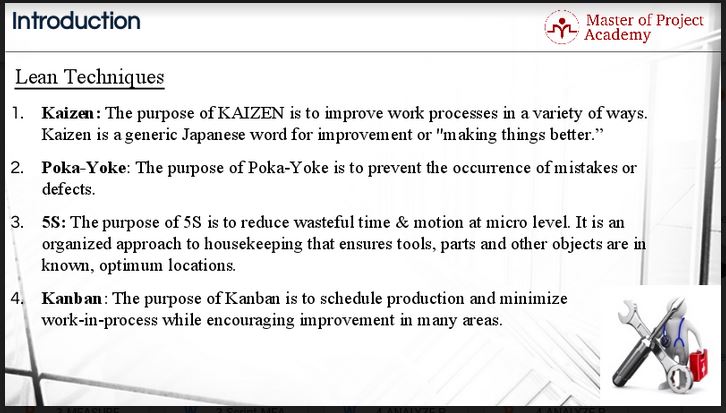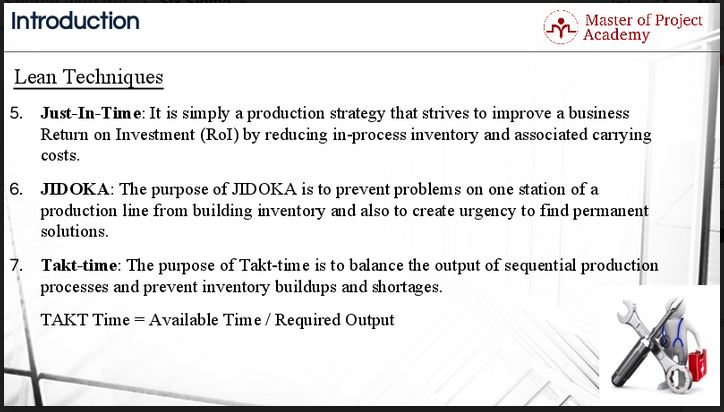Lean management is one of the top tools that eliminate types of waste in any process. Lean techniques are typically used in a production environment, and most examples in Lean training courses will focus on applying Lean techniques in these kinds of processes. The reality is that Lean techniques can be used in any environment that uses processes. Free Six Sigma Green Belt Certification trainings briefly discuss Lean Techniques. Because Lean methods and the Six Sigma method go hand in hand. Lean is part of the Six Sigma approach to problem-solving as eliminating waste goes a long way to solving problems in any process. You can read more about Lean Project Management.
- What is Power BI? We have brand new course offers for you to learn Power BI:
Attend our 100% Online & Self-Paced Free Six Sigma Training.
In this article, will be going over 8 different Lean Techniques.
Lean Techniques #1 Kaizen
The purpose of KAIZEN is to improve work processes in a variety of ways. Kaizen is a generic Japanese word for improvement or making things better. KAIZEN was created in Japan following World War II. The word Kaizen means “Continuous Improvement.” It comes from the Japanese words “kai” which means “change” or “to correct” and “zen” which means “good.”
Lean Techniques #2 Poka-Yoke
The purpose of Poka-Yoke, the second of the Lean techniques, is to prevent the occurrence of mistakes or defects. It uses a wide variety of ingenious devices to prevent mistakes. An example is an automotive gasoline tank cap having an attachment that prevents the cap from being lost. Poka-Yoke is also known as Mistake-Proofing – the Japanese approach to “Mistake Proofing” in all aspects of Lean Manufacturing, Customer Service, etc. It employs visual signals that make mistakes clearly stand out from the rest. Its older name is Baka-yoke (foolproofing). Poka-Yoke is one of the most important Lean techniques.
Lean Techniques #3 5S
Of all the Lean Techniques, 5S is the one that is focused on organizing. The purpose of 5S is to reduce wasteful time and motion at a micro-level. It is an organized approach to housekeeping that ensures tools, parts and other objects are in known, optimum locations. Actually, it is a framework to create and maintain your workplace. 5S Stands for: Sort, Set-in-order, Shine, Standardize, Sustain. The act of sorting means that all unnecessary tools and other items are removed from the workplace. Set-in-order means that all necessary items are placed in locations that minimize waste of motion. For example, tools that are used frequently are placed close to the work station while tools that are used less often are placed in storage further away from the work station. Shine means that the workplace is kept in a clean and orderly manner. Next, standardize means that all processes in a workstation are standardized. Finally, Sustain means that the workers that use the workstation maintain the standard that has been set in the previous four S’s.

Lean Technique #4 KANBAN
The purpose of the fourth of the Lean techniques, KANBAN, is to schedule production and minimize work-in-process while encouraging improvement in many areas. KANBAN establishes a small stock point (usually at the producing WorkCentre) that sends a signal when items are withdrawn by a downstream process. The producing WorkCentre replaces the items removed. Kanban literally means signboard or billboard in Japanese. Kanban utilizes visual display cards to signal the movement of material between steps of a product process. It is a scheduling system for Lean and Just-in-Time. KANBAN was developed for the Toyota production system to find to improve and maintain a high level of production.
Lean Techniques #5: Just In Time
The fifth of the Lean technique is simply a production strategy that strives to improve a business’s Return on Investment (RoI) by reducing in-process inventory and associated carrying costs. To meet JIT objectives, the process relies on signals or KANBAN between different points in the process, which tell production when to make the next part. Just-in-time is actually a manufacturing philosophy that leads to “Producing the necessary units, in the necessary quantities at the necessary time with the required quality”.

Lean Technique #6 Jidoka
The purpose of Jidoka is to prevent problems on one station of a production line from building inventory and also to create urgency to find permanent solutions. Jidoka is the practice of stopping an integrated assembly or production line when any workstation encounters problems. Such stoppages create a crisis atmosphere that encourages immediate and permanent solutions. Jidoka means “automation with a human touch”. It implements a supervisory function in a production line and stops the process as soon as a defect is encountered. The process does not start until the root cause of the defect has been eliminated. Using Jidoka in a production process is a good example of using Lean techniques to eliminate waste.
Lean Techniques #7 Takt time
The purpose of Takt time is to balance the output of sequential production processes and prevent inventory buildups and shortages. It is the average time required between output units at a particular process coordinated with final customer requirements. Takt time is one of the Lean techniques in the Lean Toolbox. It is the frequency at which a product or service must be completed in order to meet customer needs. The formula for Takt time is: TAKT Time = Available Time / Required Output
Lean techniques #8 Heijunka
Heijunka is the last of the Lean techniques that we will be discussing in this article. Heijunka is the leveling of production by both volume and product mix. This system does not build products according to the actual flow of customer orders. Heijunka takes the total volume of orders in a period and levels them out so the same amount and mix are being made each day. It means Production leveling/smoothing. It is a technique to reduce waste that occurs due to fluctuating customer demand.
Lean techniques are used to create processes that have no non-value-add parts. Any part of a process that does not add value to the consumer is eliminated using Lean techniques. Applying Lean techniques is a strict and disciplined approach to modifying and maintaining processes that add 100% value to the client and do not waste any costs with non-value-adding steps. This has a positive effect on RoI. Following Lean techniques is a must for anyone who is responsible for a process. There will always be some sort of waste in a process and using Lean techniques will help to eliminate waste.



One thought on “The 8 Essential LEAN Techniques You Need to Know”
Comments are closed.